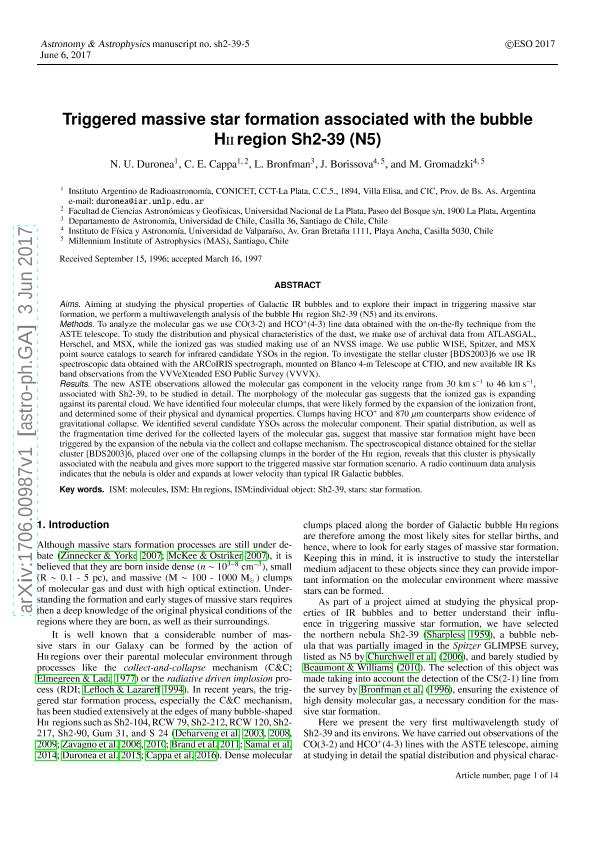Mostrar el registro sencillo del ítem
dc.contributor.author
Duronea, Nicolas Urbano

dc.contributor.author
Cappa, Cristina Elisabeth

dc.contributor.author
Bronfman, L.
dc.contributor.author
Borissova, J.
dc.contributor.author
Gromadzki, M.
dc.date.available
2017-12-19T16:23:28Z
dc.date.issued
2017-09
dc.identifier.citation
Gromadzki, M.; Borissova, J.; Bronfman, L.; Cappa, Cristina Elisabeth; Duronea, Nicolas Urbano; Triggered massive star formation associated with the bubble HII region Sh2-39 (N5); EDP Sciences; Astronomy and Astrophysics; 606; 9-2017
dc.identifier.issn
0004-6361
dc.identifier.uri
http://hdl.handle.net/11336/31022
dc.description.abstract
Aims. Aiming at studying the physical properties of Galactic IR bubbles and to explore their impact in triggering massive star formation, we perform a multiwavelength analysis of the bubble Hii region Sh2-39 (N5) and its environs. Methods. To analyze the molecular gas we use CO(3-2) and HCO+ (4-3) line data obtained with the on-the-fly technique from the ASTE telescope. To study the distribution and physical characteristics of the dust, we make use of archival data from ATLASGAL, Herschel, and MSX, while the ionized gas was studied making use of an NVSS image. We use public WISE, Spitzer, and MSX point source catalogs to search for infrared candidate YSOs in the region. To investigate the stellar cluster [BDS2003]6 we use IR spectroscopic data obtained with the ARCoIRIS spectrograph, mounted on Blanco 4-m Telescope at CTIO, and new available IR Ks band observations from the VVVeXtended ESO Public Survey (VVVX). Results. The new ASTE observations allowed the molecular gas component in the velocity range from 30 km s−1 to 46 km s−1 , associated with Sh2-39, to be studied in detail. The morphology of the molecular gas suggests that the ionized gas is expanding against its parental cloud. We have identified four molecular clumps, that were likely formed by the expansion of the ionization front, and determined some of their physical and dynamical properties. Clumps having HCO+ and 870 µm counterparts show evidence of gravitational collapse. We identified several candidate YSOs across the molecular component. Their spatial distribution, as well as the fragmentation time derived for the collected layers of the molecular gas, suggest that massive star formation might have been triggered by the expansion of the nebula via the collect and collapse mechanism. The spectroscopical distance obtained for the stellar cluster [BDS2003]6, placed over one of the collapsing clumps in the border of the Hii region, reveals that this cluster is physically associated with the neabula and gives more support to the triggered massive star formation scenario. A radio continuum data analysis indicates that the nebula is older and expands at lower velocity than typical IR Galactic bubbles
dc.format
application/pdf
dc.language.iso
eng
dc.publisher
EDP Sciences

dc.rights
info:eu-repo/semantics/openAccess
dc.rights.uri
https://creativecommons.org/licenses/by-nc-sa/2.5/ar/
dc.subject
Medio Interestelar
dc.subject
Lineas Moleculares
dc.subject
Formación Estelar
dc.subject
Regiones Hii
dc.title
Triggered massive star formation associated with the bubble HII region Sh2-39 (N5)
dc.type
info:eu-repo/semantics/article
dc.type
info:ar-repo/semantics/artículo
dc.type
info:eu-repo/semantics/publishedVersion
dc.date.updated
2017-11-16T14:44:33Z
dc.journal.volume
606
dc.journal.pais
Francia

dc.journal.ciudad
Paris
dc.description.fil
Fil: Duronea, Nicolas Urbano. Provincia de Buenos Aires. Gobernación. Comisión de Investigaciones Científicas. Instituto Argentino de Radioastronomía. Consejo Nacional de Investigaciones Científicas y Técnicas. Centro Científico Tecnológico Conicet - La Plata. Instituto Argentino de Radioastronomía; Argentina
dc.description.fil
Fil: Cappa, Cristina Elisabeth. Provincia de Buenos Aires. Gobernación. Comisión de Investigaciones Científicas. Instituto Argentino de Radioastronomía. Consejo Nacional de Investigaciones Científicas y Técnicas. Centro Científico Tecnológico Conicet - La Plata. Instituto Argentino de Radioastronomía; Argentina. Universidad Nacional de la Plata. Facultad de Ciencias Astronómicas y Geofísicas; Argentina
dc.description.fil
Fil: Bronfman, L.. Universidad de Chile. Facultad de Ciencias Fisicas y Matematicas; Chile
dc.description.fil
Fil: Borissova, J.. Universidad de Valparaiso; Chile
dc.description.fil
Fil: Gromadzki, M.. Universidad de Valparaiso; Chile
dc.journal.title
Astronomy and Astrophysics

dc.relation.alternativeid
info:eu-repo/semantics/altIdentifier/doi/http://dx.doi.org/10.1051/0004-6361/201730528
dc.relation.alternativeid
info:eu-repo/semantics/altIdentifier/url/https://www.aanda.org/articles/aa/abs/2017/10/aa30528-17/aa30528-17.html
Archivos asociados
